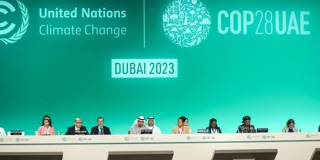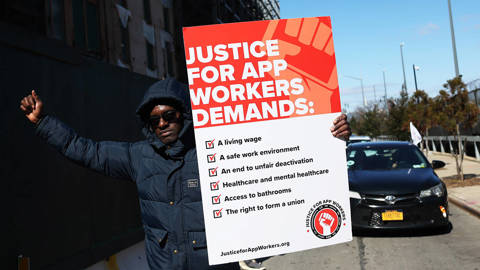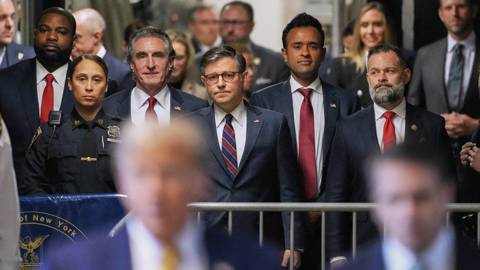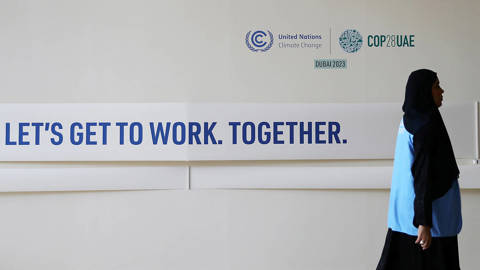Rather than focusing so much on international climate conferences that require unanimous support, rely on hollow voluntary commitments, and ultimately have little effect on emissions, policymakers should be pursuing narrower binding agreements. We already know that this strategy works and is scalable.
NEW YORK – Casual observers of the recent United Nations Climate Change Conference in Dubai (COP28) can be forgiven for attributing high stakes to the event. “We are on the brink of a climate disaster, and this conference must mark a turning point,” UN Chief António Guterres warned during the proceedings. Then, when a final agreement was reached, Canadian Environment Minister Steven Guilbeault hailed its “breakthrough commitments on renewable energy, energy efficiency, and the transition away from fossil fuels.”
But the truth is that neither the contents of the Dubai agreement, nor what was left out of it, will have much impact on climate change. We have seen this movie many times before, starting with the 1992 treaty that created the UN Framework Convention on Climate Change. Back then, all countries committed to preventing “dangerous” climate change, which would have required dramatic cuts in annual global greenhouse-gas (GHG) emissions. But emissions have continued to rise, albeit at a lower rate than they might have otherwise. Voluntary commitments have proven mostly hollow.
To be clear, we are not suggesting that fevered warnings about climate risks and the need for action are misguided. As economists who have spent decades studying climate change, we recognize that some of the economics literature has too often been used by those opposing a meaningful response. As we note in a recent report for the Institute of Global Politics, economic models that purport to identify “optimal” climate policies often systematically underestimate the benefits of emissions reductions and overestimate their costs.
Moreover, economists have let their admiration for a single policy solution, carbon taxes, get the better of them. This has given rise to misleading claims that relying on carbon prices alone is the most cost-effective way to reduce emissions. In fact, the many market failures that stand in the way of a rapid, equitable transition to net-zero emissions underscore the need for a broad portfolio of policies (which includes carbon prices).
In a world of urgent challenges, policymakers and the public have limited attention for climate change. Rather than focusing so much on international conferences that require unanimous support, entail no accountability, and ultimately have little effect on emissions, we should be directing our energies toward negotiating agreements that can achieve transformational progress in narrow, but crucial, economic sectors.
We already know that this more targeted approach works. Consider the Montreal Protocol, which protects the stratospheric ozone layer, or the International Convention for the Prevention of Pollution from Ships (MARPOL). Unlike the voluntary commitments made at each climate-change COP, these two treaties established binding obligations that can be enforced through international trade markets. The Montreal Protocol bars participating countries from trading in chlorofluorocarbons (ozone-depleting chemicals) with non-participating countries; and under MARPOL, access to ports is restricted to ships that meet certain technical standards.
These two treaties have worked because they create positive feedback effects: the more countries that agree to participate, the higher the pressure on others to join. As a result, the ozone layer will return to its pre-1980 level in a few decades, and over 99% of oil is now shipped according to MARPOL specifications, virtually eliminating a major source of marine pollution.
The same approach has already worked for climate agreements. The Kigali Amendment to the Montreal Protocol phases down hydrofluorocarbons, a powerful greenhouse gas. Like the examples above, the amendment incorporates a trade measure designed to create a positive feedback effect once a critical threshold of participation has been met. Owing to this structure, ratification is in every country’s interest. Even in polarized America, it received strong bipartisan support in the US Senate last year.
We should now do the same for other major emissions sources. Aluminum production, for example, is responsible for about 2% of global GHG emissions each year. Yet by replacing carbon anodes with inert anodes, the industry could dramatically reduce its emissions. An aluminum treaty might require that parties both switch to inert anodes and import aluminum only from other participating parties.
In contrast to unilateral threats of trade measures, this approach to international climate agreements is fundamentally cooperative and multilateral. It differs from unilaterally imposing domestic regulations on foreign production, as the European Union is doing, or from imposing carbon-based tariffs on certain imports without any corresponding domestic regulations, as some in the US have proposed. These methods may only invite retaliation.
To succeed, international climate agreements must be compatible with countries’ economic strategies, not least those of lower-income countries like India, where most future emissions will occur. That is why the Montreal Protocol and Kigali Amendment include provisions whereby richer countries agree to help poorer countries pay the costs of compliance.
The international community took the wrong lesson from the Kyoto Protocol. It should be obvious by now that relying on voluntary commitments and aspirational targets does not work. The problem with Kyoto was that it did not get the incentives right.
By focusing climate agreements on individual sectors, linking obligations to trade access, and addressing the “common but differentiated” roles of rich and poor countries in international negotiations, the world will have a better chance to achieve the goals outlined in the Dubai agreement: a rapid and equitable transition to net-zero emissions.
Then, future climate-change COPs can focus on other consequential issues, rather than on crafting the right mix of hollow words that everyone can agree on.











NEW YORK – Casual observers of the recent United Nations Climate Change Conference in Dubai (COP28) can be forgiven for attributing high stakes to the event. “We are on the brink of a climate disaster, and this conference must mark a turning point,” UN Chief António Guterres warned during the proceedings. Then, when a final agreement was reached, Canadian Environment Minister Steven Guilbeault hailed its “breakthrough commitments on renewable energy, energy efficiency, and the transition away from fossil fuels.”
But the truth is that neither the contents of the Dubai agreement, nor what was left out of it, will have much impact on climate change. We have seen this movie many times before, starting with the 1992 treaty that created the UN Framework Convention on Climate Change. Back then, all countries committed to preventing “dangerous” climate change, which would have required dramatic cuts in annual global greenhouse-gas (GHG) emissions. But emissions have continued to rise, albeit at a lower rate than they might have otherwise. Voluntary commitments have proven mostly hollow.
To be clear, we are not suggesting that fevered warnings about climate risks and the need for action are misguided. As economists who have spent decades studying climate change, we recognize that some of the economics literature has too often been used by those opposing a meaningful response. As we note in a recent report for the Institute of Global Politics, economic models that purport to identify “optimal” climate policies often systematically underestimate the benefits of emissions reductions and overestimate their costs.
Moreover, economists have let their admiration for a single policy solution, carbon taxes, get the better of them. This has given rise to misleading claims that relying on carbon prices alone is the most cost-effective way to reduce emissions. In fact, the many market failures that stand in the way of a rapid, equitable transition to net-zero emissions underscore the need for a broad portfolio of policies (which includes carbon prices).
In a world of urgent challenges, policymakers and the public have limited attention for climate change. Rather than focusing so much on international conferences that require unanimous support, entail no accountability, and ultimately have little effect on emissions, we should be directing our energies toward negotiating agreements that can achieve transformational progress in narrow, but crucial, economic sectors.
We already know that this more targeted approach works. Consider the Montreal Protocol, which protects the stratospheric ozone layer, or the International Convention for the Prevention of Pollution from Ships (MARPOL). Unlike the voluntary commitments made at each climate-change COP, these two treaties established binding obligations that can be enforced through international trade markets. The Montreal Protocol bars participating countries from trading in chlorofluorocarbons (ozone-depleting chemicals) with non-participating countries; and under MARPOL, access to ports is restricted to ships that meet certain technical standards.
SPRING SALE: Save 40% on all new Digital or Digital Plus subscriptions
Subscribe now to gain greater access to Project Syndicate – including every commentary and our entire On Point suite of subscriber-exclusive content – starting at just $49.99.
Subscribe Now
These two treaties have worked because they create positive feedback effects: the more countries that agree to participate, the higher the pressure on others to join. As a result, the ozone layer will return to its pre-1980 level in a few decades, and over 99% of oil is now shipped according to MARPOL specifications, virtually eliminating a major source of marine pollution.
The same approach has already worked for climate agreements. The Kigali Amendment to the Montreal Protocol phases down hydrofluorocarbons, a powerful greenhouse gas. Like the examples above, the amendment incorporates a trade measure designed to create a positive feedback effect once a critical threshold of participation has been met. Owing to this structure, ratification is in every country’s interest. Even in polarized America, it received strong bipartisan support in the US Senate last year.
We should now do the same for other major emissions sources. Aluminum production, for example, is responsible for about 2% of global GHG emissions each year. Yet by replacing carbon anodes with inert anodes, the industry could dramatically reduce its emissions. An aluminum treaty might require that parties both switch to inert anodes and import aluminum only from other participating parties.
In contrast to unilateral threats of trade measures, this approach to international climate agreements is fundamentally cooperative and multilateral. It differs from unilaterally imposing domestic regulations on foreign production, as the European Union is doing, or from imposing carbon-based tariffs on certain imports without any corresponding domestic regulations, as some in the US have proposed. These methods may only invite retaliation.
To succeed, international climate agreements must be compatible with countries’ economic strategies, not least those of lower-income countries like India, where most future emissions will occur. That is why the Montreal Protocol and Kigali Amendment include provisions whereby richer countries agree to help poorer countries pay the costs of compliance.
The international community took the wrong lesson from the Kyoto Protocol. It should be obvious by now that relying on voluntary commitments and aspirational targets does not work. The problem with Kyoto was that it did not get the incentives right.
By focusing climate agreements on individual sectors, linking obligations to trade access, and addressing the “common but differentiated” roles of rich and poor countries in international negotiations, the world will have a better chance to achieve the goals outlined in the Dubai agreement: a rapid and equitable transition to net-zero emissions.
Then, future climate-change COPs can focus on other consequential issues, rather than on crafting the right mix of hollow words that everyone can agree on.